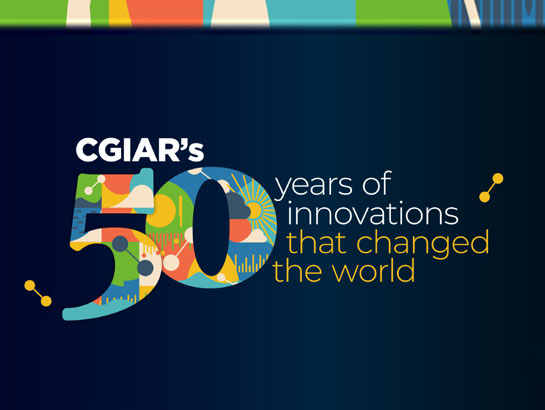CGIAR has launched an innovations campaign to mark a half century of driving cutting-edge solutions to some of the world’s most challenging problems—from food security to land and water issues amid a climate crisis. CGIAR reflects on decades of innovative ideas, products, services, and solutions driven by science, and that have made a difference in the lives of people around the world.
Comprising a global network of 15 research centers, and with presence in 108 countries, CGIAR has an unrivalled mix of knowledge, skills, and research facilities able to respond to emerging development issues. CGIAR has more than 3,000 partners from national governments, academic institutions, global policy bodies, private companies, and NGOs. CGIAR’s 50th anniversary in 2021 coincides with the drive this year to create a “One CGIAR” that will operate in a unified structure.
The CGIAR at 50 campaign highlights 3 innovations from Harvestplus, which is part of the CGIAR Program on Agriculture for Nutrition and Health (A4NH):
1. Biofortification
Starting in 2003 under the IFPRI- and CIAT-managed Biofortification Challenge Program (soon after renamed HarvestPlus), multidisciplinary CGIAR research teams successfully launched a strategy called biofortification, whereby added nutritional value is bred into familiar foods that people eat every day. The technology is now widely recognized as a practical, evidence-based approach to addressing micronutrient deficiency among smallholder farming families and other low-resource populations.
More than 50 million people in smallholder farming families in 41 countries now benefit from biofortified crops (end-2019), which are making a measurable impact on human nutrition, health and development.
2. Better Beans for Africa
Under the HarvestPlus program, 40 iron-biofortified bean varieties have been released in six African countries so far, including in Rwanda. About one in five women and four in 10 children in Rwanda are anemic. CGIAR scientists through HarvestPlus, the Alliance of Bioversity International and CIAT (then CIAT, the International Center for Tropical Agriculture), and the Rwanda Agriculture Board partnered in 2004 to develop iron-biofortified beans for Rwanda; the first varieties were released in 2010, and 10 varieties have been released to date.
The Rwanda effort has been an innovative proof of concept for sustained biofortification delivery. In 2019, the entire iron bean program was handed over to the Rwanda Bean Alliance, which includes representation from value chain actors, and engages in activities from research through consumer education.
3. Biofortification Priority Index
Scientists at HarvestPlus in 2013 developed the Biofortification Priority Index (BPI) with the aim of helping guide biofortification interventions so that they are as targeted, cost-effective, and impactful as possible. The BPI is an interactive tool that helps identify in which countries, and for which staple crops, biofortification can make the greatest impact on micronutrient deficiencies. The user-friendly tool is designed to guide strategic decisions for investment, policy and practice pertaining to the introduction and scaling of biofortified staples.
Using a methodology akin to the Human Development Index together with the most recent national-level data on micronutrient deficiency rates for vitamin A, iron and zinc, and on consumption and production of key biofortifiable staples, the BPI ranks 128 countries in Africa, Asia, and Latin America and the Caribbean regions according to their potential for impact from biofortification of local staples. The result is a clear prioritization of where biofortification interventions are most suitable – whether for investments in crop development or for introduction and scaling.
There are several other innovations submitted by other CGIAR partners that mention the contributions of HarvestPlus, such as this one from CIMMYT on iron pearl millet. You can find them all through the innovation explorer page.
